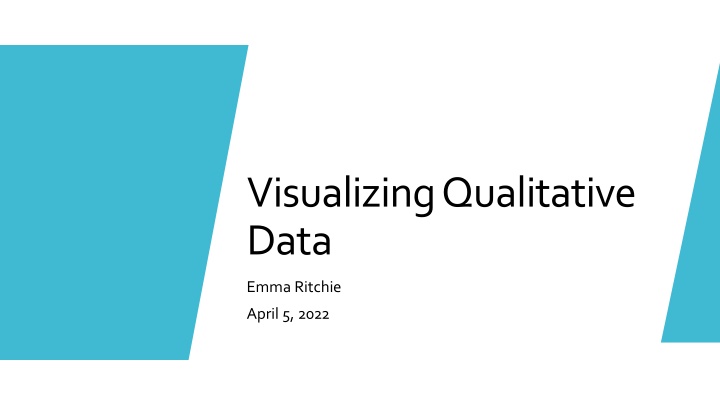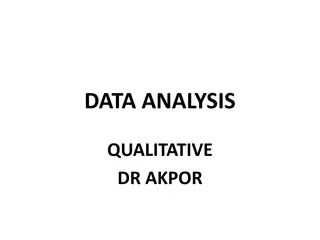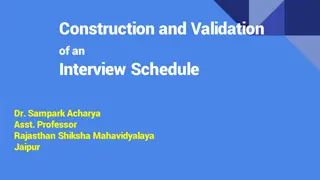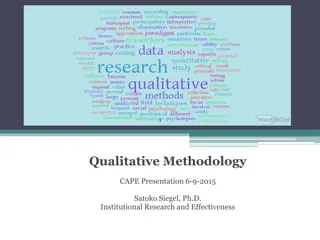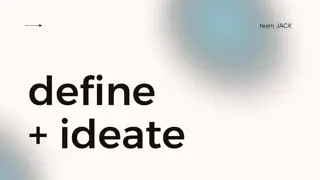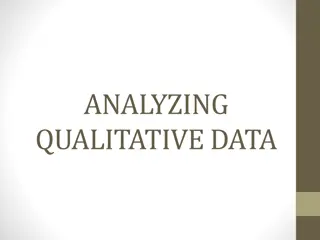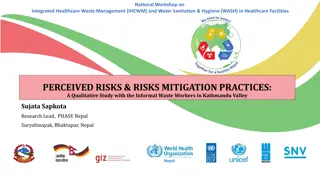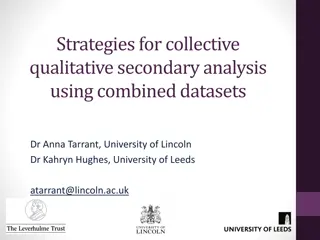Visualizing Qualitative Data - Interviews and Themes
Qualitative data collection and analysis through interviews, transcriptions, coding, and theme development. Explore how researchers interpret and extract meaning from non-numerical data, leading to rich descriptions and insights into individuals' experiences and perspectives.
Download Presentation

Please find below an Image/Link to download the presentation.
The content on the website is provided AS IS for your information and personal use only. It may not be sold, licensed, or shared on other websites without obtaining consent from the author.If you encounter any issues during the download, it is possible that the publisher has removed the file from their server.
You are allowed to download the files provided on this website for personal or commercial use, subject to the condition that they are used lawfully. All files are the property of their respective owners.
The content on the website is provided AS IS for your information and personal use only. It may not be sold, licensed, or shared on other websites without obtaining consent from the author.
E N D
Presentation Transcript
Visualizing Qualitative Data Emma Ritchie April 5, 2022
Disclaimer 2: Most of this presentation is based on an excellent paper by Pokorny et al. (2017) - all credit to them!!! Disclaimer 1: I have zero formal training in qualitative analyses Disclaimers
The Nature of Qualitative Data " the collection and analysis of non-numerical data... in order to provide rich descriptions and possible explanations of people's meaning-making, how they make sense of the world and how they experience particular events" (Coyle, 2007, p. 11) Interviews (typically semi-structured) are a common method of collecting qualitative data
Interviews are recorded and transcribed Depending on theoretical approach, several ways transcriptions can be analyzed Coding: identification of meaningful units in the text (Coyle, 2007) The Nature of Qualitative Data
Semi-structured interviews: Do you feel this could be a successful approach in treatment for people who want help for their gambling problem? Example: Dorey et al. (2022) Transcription of interviews Researcher read through transcripts (familiarization),generated codes, constructed themes, revised themes,defined themes All while drawing on the researcher's own understanding of the topic Results: Four themes were developed from the codes
Themes that many participants talked about (Figure 7.1 from Namey et al., 2007)
Different themes that tend to come up together in an interview (Figure 7.1 from Namey et al.,2007)
Difficulty in representing complexity of data Lack of transparency of analytic process Problems with Qualitative Data (Pokorney et al., 2017)
Viewing Qualitative Data as a Network Edge Relationship between Codes Code Node (Pokorney et al., 2017)
Viewing Qualitative Data as a Network "I'm concerned about the potential of clients being coerced... perhaps a family member wants the reward and they pressure the client to participate so the family member can get the reward. Clients might be coerced give rewards to someone else Client might conceal true struggles for rewards "I think there's potential for this to negatively impact the client. This is a vulnerable population. If they end up gambling despite the rewards, they might feel worse about themselves and conceal the truth from us. Clients could sell incentives to gamble The rewards have monetary value, I assume... so that means too that the clients could sell them to make money to gamble." Clients feel unworthy of rewards *Quotes and network are made up, codes are from the study (Dorey et al., 2022)
1 2 3 4 Code interview with qualitative analysis software (e.g., NVivo) Import interview data into software that can graph networks (Gephi, some packages in R including igraph, statnet, and network) Resulting network will portray the interrelation of codes Remember: any interpretations are influenced by the way the researcher determined the edges between nodes How To: Network Analysis (Pokorney et al., 2017)
Network Descriptives Network size Number of nodes and edges Average path length: # of edges travelled to connect two random nodes Graph density: # of edges per node : # of all possible edges Weight of edges: reflects quality, intensity, or duration between two nodes Weighted degree Accounts for the number (degree) and strength (weight) of the edges Measure of a node's connectedness and importance within a network (Pokorney et al., 2017)
Data: effect of participating in a 3-month Buddhist meditation retreat Subject codes: what is being talked about Summarize general topics and subtopics Data-prompted, not a priori Example: Subject Code Networks Community: clusters of nodes that are well-connected to each other (Pokorney et al., 2017)
Low density High average path length High network diameters (Figure 2 from Pokorney et al., 2017)
Theme coding: Grouping together "concepts, events, persons, and concerns" (Pokorney et al., 2017, p. 8) that fit with a predefined label Allows to see how common themes are and relatedness to other themes Example 2: Network of Theme Codes Themes capture concepts in data that is useful for research questions (Pokorney et al., 2017)
Conclusion Network analysis is anattempt to make qualitative data easier to visualize and read, and to make it more engaging Networks are dynamic (not static as shown in pictures) and can be interactive Certain software allows a "playback" if interviews are coded with timestamps Provision of network descriptives another way to understand qualitative data Flexible, adaptive to each researcher, their approach, their questions Allows other researchers to critically evaluate data if networks are publicly available (Pokorney et al., 2017)
Coyle, A. (2007). Introduction to qualitative psychological research. In E. Lyons & A. Coyle (Eds.), Analysing qualitative data in psychology (pp. 9 29). Sage Publications Ltd. https://doi.org/10.4135/9781446207536.d7 Dorey, L., Christensen, D. R., May, R., Hoon, A. E., & Dymond, S. (2022). Gambling treatment service providers views about contingency management: A thematic analysis. Harm Reduction Journal, 19, Article 19. https://doi.org/10.1186/s12954-022-00600-0 Geerling, L. (2015). Cultural negotiations in transnational knowledge: Cases of clinical psychology from the Malay Archipelago and beyond [unpublished master s thesis]. James Cook University. https://doi.org/10.13140/RG.2.1.2561.9284 Namey, E., Guest, G., Thairu, L., & Johnson, L. (2007). Data reduction techniques for large qualitative data sets. In G. Guest & K. MacQueen (Eds.), Handbook for team-based qualitative research (pp. 137 163). Altamira Press. Pokorney, J. J., Norman, A., Zanesco, A. P., Bauer-Wu, S., Sahdra, B. K., & Saron, C. D. (2017). Network analysis for the visualization and analysis of qualitative data. Psychological Methods, 23(1), 169-183. https://doi.org/10.1037/met0000129 References
